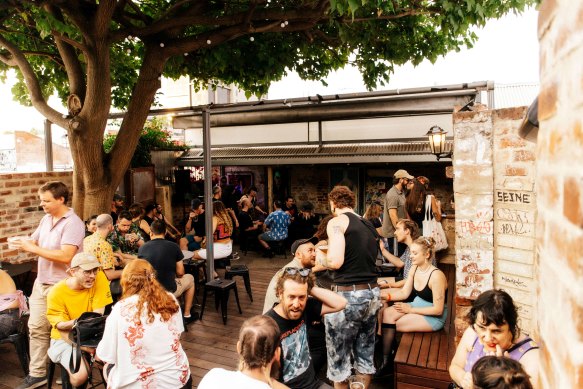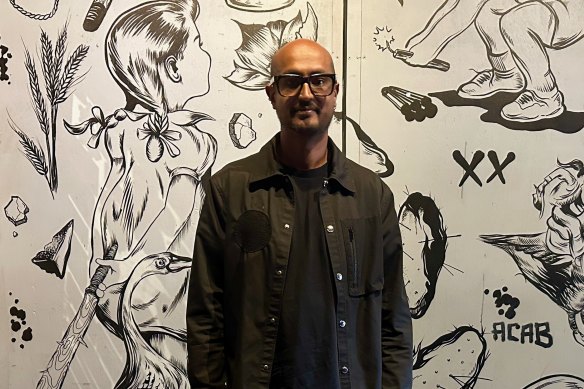The Bird is one of the busiest small music venues in Perth — and one of the most important.
Since 2010, it has been a launch pad for hundreds of local acts. Some, such as Tame Impala and Stella Donnelly, have gone on to national and international careers and cemented Perth as a music hothouse.

The courtyard at Northbridge live music hangout The Bird.Credit: Cole Currie
Pop into this intimate Northbridge venue virtually any night of the week and it will be full of music aficionados, young and old (mostly young), eager to get an early look at an act that may be the next big thing.
Yet for all its success, The Bird is under threat because its core audience is not drinking as much as previous generations.
While the artists get most of the cost of entry, the bar relies on alcohol sales. So venues such as The Bird, and Mojos in North Fremantle, are in danger of folding because the young patrons are not putting it away like their parents and grandparents.
“People are still going to live music, but they are not drinking as much. Bar sales are down by 20 to 30 per cent,” says The Bird’s director Kabir Ramasary, who last year appealed to the public to save his venue with a fundraising campaign.

Social habits are changing, says The Bird director Kabir Ramasary.Credit: Mark Naglazas
“And when there is no live music on there are not as many people about. The 18-25 group just don’t have that much money, so they have to choose what they do, and they are doing other things, like going to big concerts.
“Social habits are changing. Young people are meeting up in places other than bars. They go to the gym, they meet in parks, they go on bush walks. Bars and pubs and drinking are not the only option.”
Emma Adams, an artist manager who also books performers for both The Bird and Mojos, agrees venues are still filling up, but crowds are not drinking enough to cover expenses.
“It costs money to keep a venue like The Bird running,” she says.
“Sound technicians need to be paid. Money has to go into marketing, a booking agent, a door person, maintenance of equipment.
“The downturn means that the venues are having to pass more of the cost on to artists. Artists have always had to pay to use the venue, but this is increasing because the venues are not making enough money on alcohol sales.
“The Bird plays an important role in fostering young artists and contributing to the liveliness and diversity of the music scene.
“There is a huge demand for The Bird and Mojos, so to lose them would be terrible for the local music scene.”

Mark Neal and Emma Adams. Credit: Mark Naglazas
Three major live music venues in Perth city closed last year – Badlands Bar, The Convenience Store and The Sewing Room.
Mark Neal, who booked bands for The Sewing Room until it closed, believes the cost of living is driving the downturn in drinking and endangering the live music scene.
Neal also says the core audience is now more cautious about getting drunk in public and potentially having their condition immortalised on social media.
Alcohol plays such an important role in the financial health of live music venues that it is impacting on their choice of performers.
“If you book a legacy act or a pub rock band you know they’re going to bring in a drinking crowd. If you book a gentle folky type, you know the audience will not drink as much, which is not good for the venue,” Neal says.
The post-COVID return of mega acts such as Coldplay, Taylor Swift and Pink and headline-grabbing pop-up gigs such as Fred Again is also presenting a major challenge to the local live music scene, as well as festivals such as the recently cancelled Splendour in the Grass.
“Getting drunk is not high on the agenda of young people who would rather save for a major music event, which means they are going out once a month rather than once a week,” Neal says.
The impact on the music scene of the decline in drinking in the younger demographic is not restricted to Perth.
More than 1000 live music venues have closed in London in the past three years, with commentators now fearing that the more restrained lifestyle of Gen Z is destroying nightlife in the UK.
This new sobriety is beginning early and sticking around, according to Associate Professor Dr Michael Livingston of the National Drug Research Institute at Curtin University.
“It’s not great messaging. On the one hand, we are sharing a beautiful art form, on the other we are telling people they must drink if it is to survive.”
Kabir Ramasary
“Underage drinking has more than halved in the past two decades,” Livingston says.
“In the past, 70 per cent of 15-year-olds consumed alcohol in significant amounts. And that disinclination to drink is staying until their 20s. Drinking amongst teenagers is now a very minor activity.”
And it is not just in Australia, argues Livingston. Drinking among the young is declining in high-income countries across the globe — in most of Northern Europe, in the Nordic countries, in the UK, US, New Zealand and Canada.
Livingston says researchers have been working hard to understand why Gen Z are turning their backs on booze and tentatively conclude the best explanation is more enlightened parenting.
“Parents are more concerned about the impact of drinking and less inclined to supply their children with alcohol or condone it and more likely to have conversations about the dangers of binge drinking,” he says.
Livingston has found the major reason young people are drinking less is that they are more risk averse.
“It is not limited to alcohol consumption,” he says.
“Young people are less likely to engage in all kinds of risky behaviour. They are much more cautious, have more anxiety and are more concerned about their futures than their parents and grandparents’ generations.
“Classically the teens and early 20s are the years for experimentation and pushing the boundaries, for taking the gap year before uni and taking on a crappy job or going on the dole and finding yourself.
“We are finding when we talk to young people that they are more concerned with getting things lined up and keeping things on track than figuring themselves out.”
It appears, however, this new-found sobriety is coming at the same time as a rise in mental illness.
“We are not sure yet, but it seems that the decline in drinking and other forms of risky behaviour and increase in anxiety and depression all stem from uncertainty, from worries about such issues as climate change and the housing crisis,” Livingston says.
Ramasary worries about the viability of his and other live music venues, but is equally concerned the industry is so dependent on booze.
“Are we doing the right thing encouraging people to drink to keep live music alive?” he asks.
“It’s not great messaging. On the one hand, we are sharing a beautiful art form, on the other we are telling people they must drink if it is to survive.”
Start the day with a summary of the day’s most important and interesting stories, analysis and insights. Sign up for our Morning Edition newsletter.